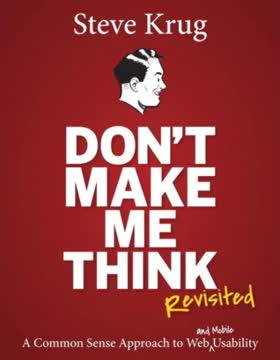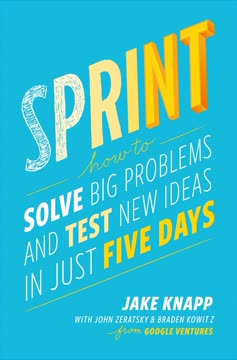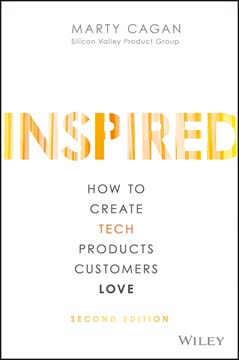Key Takeaways
1. The Hook Model: A Framework for Building Habit-Forming Products
Habit-forming technologies are the invisible engines that power our daily lives.
The Hook Model consists of four phases: trigger, action, variable reward, and investment. This cycle, when repeated, creates powerful user habits. Companies like Facebook, Twitter, and Pinterest have successfully implemented this model to create products that users engage with frequently and unprompted.
Key components:
- Trigger: The actuator of behavior
- Action: The simplest behavior in anticipation of reward
- Variable Reward: The satisfaction of user needs while leaving them wanting more
- Investment: Where users put something of value into the system, increasing their likelihood of returning
By understanding and implementing these phases, product designers can create experiences that align with users' problems and desires, ultimately leading to automatic behaviors and increased engagement.
2. Triggers: The Spark That Initiates User Behavior
External triggers are embedded with information, which tells the user what to do next.
Triggers come in two types: external and internal. External triggers are environmental cues, such as an email, app icon, or notification. Internal triggers manifest automatically in the mind and are often negative emotions like boredom, fear, or indecision.
Effective triggers:
- Are well-timed and actionable
- Spark both immediate and long-term engagement
- Transition users from external to internal triggers over time
To create habit-forming products, designers must understand their users' internal triggers and use external triggers to prompt initial engagement. As users repeatedly engage with the product, they form associations between the product and their internal needs, eventually leading to automatic behavior.
3. Action: Simplifying the Path to Reward
To increase the likelihood of a behavior occurring, Fogg instructs designers to focus on simplicity as a function of the user's scarcest resource at that moment.
Simplicity is key to driving user action. The easier an action is to perform, the more likely users are to do it. This phase draws on the Fogg Behavior Model, which states that for a behavior to occur, three elements must converge: motivation, ability, and a trigger.
To increase ability:
- Reduce time required
- Decrease monetary cost
- Minimize physical effort
- Lower cognitive load
- Align with social norms
- Make actions non-routine
Successful products like Google, Twitter, and Instagram have mastered the art of simplifying user actions. By removing obstacles and making desired behaviors easier to perform, these companies have increased user engagement and formed strong habits.
4. Variable Reward: The Unpredictable Thrill That Keeps Users Engaged
Variable rewards are one of the most powerful tools companies implement to hook users.
The power of variability lies in its ability to heighten users' engagement and motivation. When rewards are unpredictable, they create a focused state of mind, activating the brain's dopamine system and suppressing areas associated with judgment and reason.
Three types of variable rewards:
- Tribe: Social rewards from other people
- Hunt: Search for material resources or information
- Self: Intrinsic rewards of mastery or completion
Companies like Facebook (tribe), Twitter (hunt), and Codecademy (self) effectively use these reward types to keep users coming back. By satisfying users' needs while leaving them wanting more, variable rewards create a powerful drive to return to the product.
5. Investment: How User Effort Increases Product Value
The big idea behind the Investment Phase is to leverage the user's understanding that the service will get better with use (and personal investment).
The Investment phase is crucial for creating long-term engagement. It involves users putting something of value into the system, which increases their likelihood of returning. This phase leverages several psychological principles, including the sunk cost fallacy and the endowment effect.
Forms of investment:
- Time
- Data
- Effort
- Social capital
- Money
Investments can improve the service for future use, invite users to "store value" in the platform, or prompt users to make further investments. Examples include LinkedIn's profile completion, Tinder's swiping mechanism, and Snapchat's streaks feature. By encouraging small investments, products become more valuable to users over time, increasing the likelihood of continued engagement.
6. Ethical Considerations in Designing Habit-Forming Technologies
The Hook Model is fundamentally about changing people's behaviors, but the power to build persuasive products should be used with caution.
The Manipulation Matrix is a tool for entrepreneurs to assess the ethics of their habit-forming products. It asks two key questions: "Would I use the product myself?" and "Will the product help users materially improve their lives?"
Four types of creators:
- Facilitators: Create products they would use and believe improves users' lives
- Peddlers: Believe their product improves lives but wouldn't use it themselves
- Entertainers: Create products they would use but don't necessarily improve lives
- Dealers: Create products they wouldn't use and don't believe improve lives
Product creators should strive to be Facilitators, creating products that genuinely improve users' lives while being mindful of potential negative impacts. This approach not only aligns with ethical considerations but also increases the likelihood of long-term success.
7. Identifying Opportunities for Habit-Forming Products
Wherever new technologies suddenly make a behavior easier, new possibilities are born.
Opportunities for innovation often arise from technological advancements, changes in user behavior, or shifts in interface design. By identifying these opportunities, entrepreneurs can create products that solve real user needs and form lasting habits.
Areas to explore:
- Nascent behaviors: Early adoption patterns that could become mainstream
- Enabling technologies: New infrastructures that make certain behaviors easier
- Interface changes: Shifts in how users interact with technology
Examples include the rise of smartphones enabling mobile-first products, social media platforms leveraging user-generated content, and wearable technologies creating new possibilities for health and fitness applications. By staying attuned to these shifts, entrepreneurs can identify unique opportunities to create habit-forming products.
8. The Habit Testing Process: Measuring and Improving User Engagement
Habit Testing helps uncover product devotees, discover which product elements are habit forming (if any), and why those aspects of your product change user behavior.
The Habit Testing process involves three steps: identify, codify, and modify. This iterative approach helps product designers measure and improve the habit-forming potential of their products.
Steps in Habit Testing:
- Identify: Determine who your devoted users are
- Codify: Understand what actions these devoted users take
- Modify: Adapt your product to encourage more users to follow the same path
Key metrics to consider include frequency of use, percentage of devoted users, and specific behavioral patterns. By continuously testing and refining your product based on user data, you can increase its habit-forming potential and overall success.
Last updated:
FAQ
What's "Hooked: A Guide to Building Habit-Forming Technology" about?
- Author and Purpose: Written by Nir Eyal with Ryan Hoover, the book explores how to create habit-forming products using psychological principles.
- Core Concept: It introduces the Hook Model, a four-step process that companies use to encourage user habits.
- Target Audience: The book is aimed at entrepreneurs, product managers, and designers interested in understanding user behavior.
- Practical Application: It provides actionable insights for building products that people use regularly without relying on expensive marketing.
Why should I read "Hooked: A Guide to Building Habit-Forming Technology"?
- Understand User Behavior: Gain insights into the psychological triggers that drive user engagement and retention.
- Improve Product Design: Learn how to design products that become a natural part of users' routines.
- Competitive Advantage: Discover how habit-forming products can provide a significant edge in crowded markets.
- Ethical Considerations: The book also addresses the moral implications of creating addictive technologies.
What is the Hook Model in "Hooked"?
- Four Phases: The Hook Model consists of Trigger, Action, Variable Reward, and Investment.
- Trigger: Initiates the behavior, can be external (notifications) or internal (emotions).
- Action: The simplest behavior in anticipation of a reward.
- Variable Reward and Investment: Keeps users engaged by offering unpredictable rewards and encouraging them to invest in the product.
What are the key takeaways of "Hooked: A Guide to Building Habit-Forming Technology"?
- Habit Formation: Understand how habits are formed and the role of frequency and perceived utility.
- User Engagement: Learn how to create products that users return to without external prompting.
- Investment Phase: Discover how user investment increases the likelihood of repeated engagement.
- Ethical Design: Consider the moral responsibilities when designing habit-forming products.
How does "Hooked" define a habit?
- Automatic Behavior: Habits are defined as behaviors done with little or no conscious thought.
- Triggered by Cues: They are often triggered by situational cues, either external or internal.
- Engineered Actions: The book explains how products can be designed to become habitual.
- Impact on Behavior: Habits significantly alter everyday behavior as intended by designers.
What are the types of triggers in the Hook Model?
- External Triggers: These include notifications, emails, and app icons that prompt user action.
- Internal Triggers: These are emotions or thoughts that cue behavior without external prompts.
- Transition from External to Internal: Successful products transition users from external to internal triggers.
- Example: A user might initially be prompted by a notification but later use the product out of habit.
What role do variable rewards play in the Hook Model?
- Create Cravings: Variable rewards create a craving that drives users to return.
- Types of Rewards: The book identifies three types: rewards of the tribe (social), hunt (material), and self (intrinsic).
- Unpredictability: The unpredictability of rewards keeps users engaged.
- Example: Social media platforms use likes and comments as variable rewards.
How does the investment phase work in the Hook Model?
- User Effort: Users invest time, data, or effort, increasing the product's value to them.
- Future Rewards: Investments are about anticipating future rewards, not immediate gratification.
- Stored Value: The more users invest, the more valuable the product becomes to them.
- Example: Following someone on Twitter increases the likelihood of returning to the platform.
What are the ethical considerations discussed in "Hooked"?
- Manipulation Concerns: The book addresses the potential for products to become addictive.
- Moral Responsibility: Designers have a responsibility to ensure their products improve users' lives.
- Manipulation Matrix: A tool to assess whether a product is ethical based on its impact and the designer's use.
- Facilitator Role: Encourages creating products that the designer would use and that improve lives.
What are some real-world examples used in "Hooked"?
- Instagram: Used as an example of how external triggers can become internal.
- Pinterest: Demonstrates the use of variable rewards through endless scrolling.
- Twitter: Shows how user investment in followers increases engagement.
- Bible App Case Study: Illustrates the application of the Hook Model in a religious context.
How can I apply the concepts from "Hooked" to my product?
- Identify Triggers: Determine what internal and external triggers will prompt user action.
- Simplify Actions: Make the desired user actions as easy as possible.
- Incorporate Variable Rewards: Use unpredictability to keep users engaged.
- Encourage Investment: Design ways for users to invest in the product, increasing its value to them.
What are the best quotes from "Hooked" and what do they mean?
- "First-to-mind wins": Highlights the importance of being the go-to solution for users.
- "Habits give companies greater flexibility to increase prices": Explains the economic advantage of habit-forming products.
- "If it can’t be used for evil, it’s not a superpower": Discusses the dual nature of habit-forming technology.
- "The Hook Model is fundamentally about changing people’s behaviors": Emphasizes the core purpose of the book's framework.
Review Summary
Hooked receives mostly positive reviews for its clear framework on building habit-forming products. Readers appreciate the actionable insights and psychological principles behind user engagement. Some criticize the book's length and ethical implications of "hooking" users. The Hook Model's four steps—trigger, action, variable reward, and investment—are widely discussed. Many find it valuable for product design and understanding user behavior, while others question its potential for manipulation. Overall, it's considered a useful read for entrepreneurs and product managers, despite some reservations about its approach.
Similar Books










Download PDF
Download EPUB
.epub digital book format is ideal for reading ebooks on phones, tablets, and e-readers.





